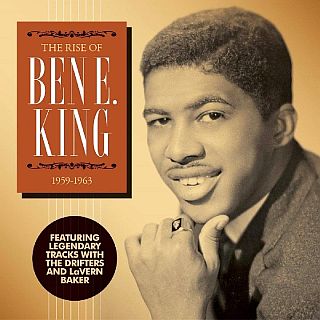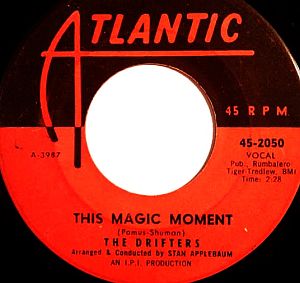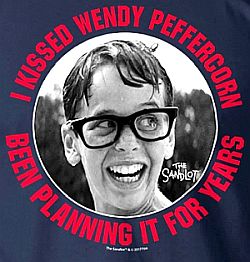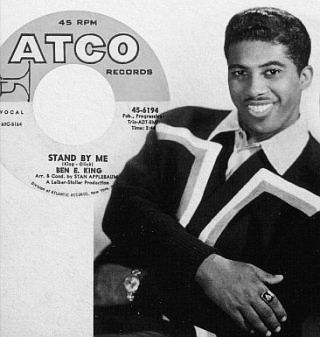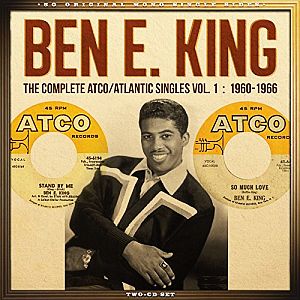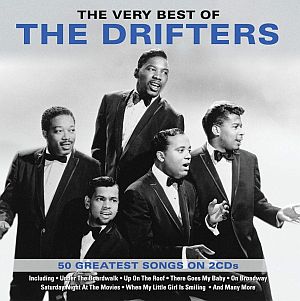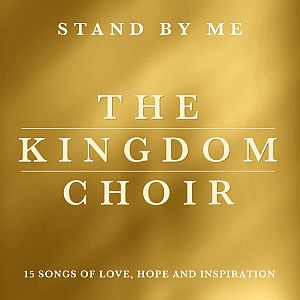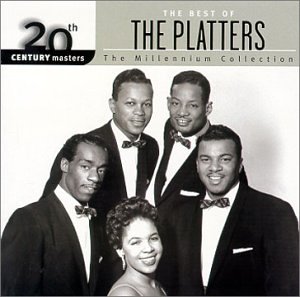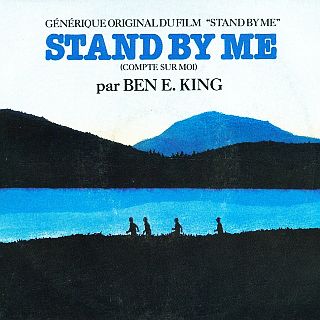
Ben E. King’s famous 1961 hit, “Stand By Me,” rose again on the 1987 pop charts after it was used in the soundtrack for the Rob Reiner film of that name. Click for soundtrack or single.
Music Player
“Stand By Me” – Ben E. King
King recorded “Stand By Me” in 1961 after he had left the Drifters. The song, written by King, along with Jerry Leiber and Mike Stoller, came out of the Brill Building-era of song production, a time when some hits would be generated by songwriters and artists working together, producing some of the best R&B and pop music of those times.
“Stand By Me” rose to No. 1 on the R & B chart and No. 4 on the pop charts in June of 1961. A second round of popularity for the song came more than 25 years later, after King’s version backed the famous 1987 Rob Reiner film by that name, again rising into the Top Ten of the U.S. and most European charts at that time, hitting No. 1 in the U.K. More on the film and the song in a moment. But first, a little history on King and his early success with The Drifters.
Ben E. King was born in Henderson, North Carolina in 1938, then named Benjamin Earl Nelson. In 1947, at the age of nine, he moved with his family to Harlem, New York. As a boy, he sang in church choirs. In high school he formed a doo-wop group that occasionally performed at the Apollo.In 1958, still using his birth name, King joined the Five Crowns doo-wop group. The Crowns performed that year at the Apollo Theater on a bill with the original Drifters group and attracted the attention of George Treadwell, who then managed the Drifters and owned the name.
The Apollo appearance proved timely for the Crowns and Treadwell, who had just lost his lead singer from the Drifters to military service. Treadwell then fired the remaining Drifters and hired Ben E. King and the Crowns to replace them as the new Drifters.
(Note: The Drifters’ considerable music history is complex, stretching over many years and numerous personnel, from 1955 when first formed by Clyde McPhatter, continuing through later years with an ever-changing roster of artists).

Record sleeve for later issue of “There Goes My Baby” single, depicting, from left: Charlie Thomas, Ben E. King, Doc Green & Elsbeary Hobbs. Click for digital single.
Music Player
“There Goes My Baby” – 1959
Ben E. King & The Drifters
Released in April 1959, the song reached No, 2 on the Billboard Hot 100 and No. 1 on the Billboard R&B chart for two weeks in the summer of 1959. This song, and others to follow, were among the first rock and R&B songs of that era to use strings in the instrumentation.
“There Goes My Baby,” is about a relationship gone bad, in which King as narrator offers some self-assessment of his role in its demise, now paying the price of loneliness. I broke her heart, and made her cry / Now I’m alone, so all alone / What can I do, what can I do? Later in the song, there are some interesting flourishes of strings surrounding King’s questions.
King, meanwhile, continued to sing lead on a succession of Drifters’ hits, written and composed by Doc Pomus and Mort Shuman, one of the songwriting teams at the famed New York Brill Building. Among other Benny King/Drifters hits were: “Save the Last Dance For Me”, “This Magic Moment”, and “I Count the Tears.”
|
“This Magic Moment” This magic moment And then it happened Sweeter than wine This magic moment Sweeter than wine This magic moment |
The Ben E. King / Drifters version of “This Magic Moment,” for example – released in January 1960 – entered the Billboard Hot 100 on February 16th, 1960 and would peak at No. 16 on March 28th, remaining on that chart for 11 weeks. It also hit No. 4 on the R&B charts and spent 11 weeks on that chart. The Drifters then included: Ben E. King, Charlie Thomas, Dock Green, and Elsbeary Hobbs.
Music Player
“This Magic Moment” – 1960
Ben E. King & The Drifters
“This Magic Moment” used strings to good effect, especially at the song’s opening, in a swirling statement of something special to come. And they continue in background throughout the song, punctuated by acoustic guitar during the summer night verse, and complimented by The Drifters’ backing chorus.
Jerry Leiber and Mike Stoller were the producers, bringing in session musicians to polish the production. Among those musicians were: Phil Bodner (sax), Ernie Hayes (piano), Bucky Pizzarell and George Barnes (guitar), George Duvivier (bass), and Shep Sheppard (drums).
The “magic moment,” of course – the song’s central thesis – has to do with young love. Magic is indeed part of what happens in that first flush of new love – a hard thing to articulate and capture, whether in music or in life.
Yet, the people involved in the moment know it when it happens, as King acknowledges: …And then it happened / It took me by surprise / I knew that you felt it too / By the look in your eyes. The moment, as King describes it, is perfect. It’s everything; nothing else is needed. “Sweeter than wine / Softer than a summer night / Everything I want I have / Whenever I hold you tight.”
Can it last forever? Surely it must! And for some it does – in marriages and unions that last for decades. Yet for most, “the moment” is just that; a romantic moment in time shared with another; though still cherished and embedded in the emotional brain — a love moment that brings a good feeling when recalled, endorphins to follow.For those who fell in love when this song was popular, or had a special moment with a lover, the song can summon a powerful rush of deep-brain memory of time, place, and person — even when heard decades later. Thus, “music and moment” can prove a potent combo, lasting well beyond first encounters.
The song for Baby Boomers has a special pull, as they were impressionable teens in those early- and mid-1960s years. But listeners of all ages are moved by this Ben E. King song. One YouTube respondent from Gen-Z notes: “I was born in 2004 but I am in love with this music.”
In fact, a review of comments at any of several YouTube postings of this song reveal praise and appreciation from a range of listeners: “One of the most romantic songs ever made. Truly timeless,” says one. Another notes: “I walked down the aisle of my wedding to this song as a surprise to my future husband. Everyone thought it was perfect for the occasion.” Big Phil adds, “One of the best songs ever written.” Some reported feeling “chills” with the opening strings. Ronnie notes that in his case, a marriage resulted: “I had a magic moment the first time I kissed the girl who later became my wife of 44 yrs.” Jimmy, on the other hand, acknowledges loss and magic: “I remember my first magic moment. I thought it would last till the end of time. It didn’t. But that moment was magic.” Others are moved by how the song conjures up a more innocent time. Says Steve: “I was 16 when this first came out. I’d love to get back there…” And Bruce of Boomer vintage says: “…Loved it as a kid and still love it at 74.”
The Squints Caper. On a lighter and more comical note, the song is also recalled by some for a memorable scene in the 1993 film, The Sandlot, a coming-of-age story that follows a group pre-teen boys who play sandlot baseball, revealing a warts-and-all cast of characters and experiences during the growing-up years.“This Magic Moment” is one of a number of excellent 1950s-1960s hit songs used in the soundtrack. It is played during a scene involving the character known as “Squints” (for his glasses), who has a fantasy longing for an older, voluptuous female life guard at the local swimming pool named Wendy Peffercorn.
Squints succeeds in getting the attention of Wendy, by way of a daring but faked drowning at the pool, thereby receiving mouth-to-mouth resuscitation from Wendy (as “This Magic Moment” plays). But Wendy soon discovers the ruse, calling Squints “a little pervert,” and bans the entire sandlot bunch from the pool thereafter.
Squints, however, is quite pleased with himself for his accomplishment, now elevated in standing among his peers for his daring deed. (T-shirts commemorating the Squints-Wendy event are available at WalMart and Amazon. And oh, yes, according to the film, some years later, Squints and Wendy would marry and have nine kids).
“This Magic Moment” would also become a Top Ten hit for Jay and Americans in March 1969, reaching No. 6 in the U.S. and No. 1 in Canada. But many purists of the 1960s’ era prefer the Ben E. King/Drifter’s version. Ben E. King, meanwhile, would record 13 songs with the Drifters, 11 as the group’s lead singer. But he had his differences with the group and their manager, and decided to leave the group. By May 1960, Ben E. King embarked on a solo career.
King’s Solo Hits
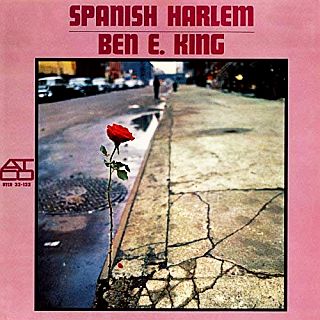
Atlantic album cover for Ben E. King’s 1961 album, “Spanish Harlem,” featuring 12 songs. Click for album.
It was written by Jerry Leiber and Phil Spector and produced by Jerry Leiber and Mike Stoller. Leiber has credited Stoller with the song’s arrangement
Music Player
“Spanish Harlem”- Ben E. King
1960
“Spanish Harlem” was originally released in December 1960 as the B-side of “First Taste of Love.” But “Spanish Harlem” climbed the Billboard charts with an arrangement by Stan Applebaum that featured Spanish guitar, marimba, drum-beats, soprano saxophone, strings, and a male chorus. The song peaked at No. 15 on the R&B chart and No. 10 on the pop chart. It has also been ranked at No. 358 on Rolling Stone magazine’s list of the “500 Greatest Songs of All Time.”
In 1961, the single was followed by a stereo album also titled Spanish Harlem with 12 tracks: 1.) Amor, 2.) Sway, 3.) Come Closer To Me, 4.) Perfidia, 5.) Granada, 6.) Sweet And Gentle, 7.) Perhaps, Perhaps, Perhaps, 8.) Frenesi, 9.) Souvenir Of Mexico, 10.) Besame Mucho, 11.) Love Me, and 12.) Spanish Harlem.
But it was “Stand By Me” that would become King’s defining work.Stand By Me
“Stand By Me” was the name of a gospel hymn written by the Philadelphia minister Charles Albert Tindley in 1905. His hymn became popular in churches throughout the American South and was recorded by various gospel acts in the 1950s.
One popular adaptation was by The Staple Singers, who recorded it in 1955. It was this version that Ben E. King heard, and wanted The Drifters to record it, but the group’s manager rejected it.
So after King went out on his own, and during the recording session for “Spanish Harlem,” some additional studio time became available. And that’s when “Stand By Me” was created.
King, Leiber and Stoller then worked together to flesh out the melody and complete the lyrics, with Stoller adding the signature bass line at the beginning. King has cited singers Brook Benton, Roy Hamilton, and Sam Cooke as influences for his vocals on the song.
|
“Stand By Me” When the night has come No I won’t be afraid, no I won’t be afraid So darlin’, darlin’, stand by me, oh stand by me If the sky that we look upon I won’t cry, I won’t cry, no I won’t shed a tear And darlin’, darlin’, stand by me, oh stand by me And darlin’, darlin’, stand by me, oh stand by me Whenever you’re in trouble Oh stand by me, stand by me [ fade out…] Whenever you’re in trouble… |
“Stand by Me” would ultimately be voted as one of the Songs of the Century by the Recording Industry Association of America (RIAA).
In one interview, co-writer Mike Stoller has described how the song came together:
… Ben E. had the beginnings of a song—both words and music. He worked on the lyrics together with Jerry, and I added elements to the music, particularly the bass line. To some degree, it’s based on a gospel song called “Lord Stand By Me”. I have a feeling that Jerry and Ben E. were inspired by it. Ben, of course, had a strong background in church music. He’s a 50% writer on the song, and Jerry and I are 25% each.
…When I walked in, Jerry and Ben E. were working on the lyrics to a song. They were at an old oak desk we had in the office. Jerry was sitting behind it, and Benny was sitting on the top. They looked up and said they were writing a song. I said, “Let me hear it.”
… Ben began to sing the song a cappella. I went over to the upright piano and found the chord changes behind the melody he was singing. It was in the key of A. Then I created a bass line. Jerry said, “Man that’s it!” We used my bass pattern for a starting point and, later, we used it as the basis for the string arrangement created by Stanley Applebaum.
Of King’s vocal qualities, Ken Emerson, author of Always Magic in the Air: The Bomp and Brilliance of the Brill Building Era, has noted: “He had a way of retaining a gospel grit in his voice but at the same time had an easy, debonair style that was appealing and ingratiating.”
Listed at No. 72 in Dave Marsh’s 1989 book, The Heart of Rock and Soul: The 1001 Greatest Singles Ever Made, Marsh describes the song as follows:
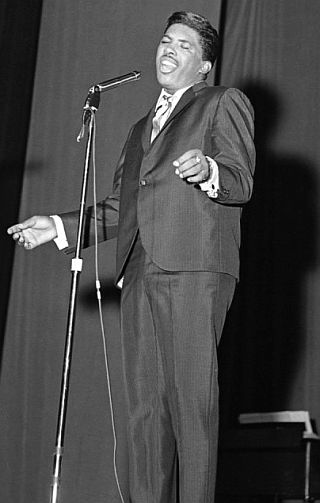
August 3, 1963. Ben E. King performs on stage during Murray The K's Big Holiday Show at the Brooklyn Fox Theater, New York, NY. (Photo, PoPsie Randolph / Michael Ochs Archives).
It’s not hard to see how “Stand By Me” could reenter the Top Ten twenty-five years after it was first made [i.e., after the Riner film]. It’s as timeless as a basic black dress. The theme was provided by gospel, the bass and percussion are Afro-Cuban. But the rifling cellos and soft quartet harmonies, the way the arrangement builds, adding instruments and growing more lush at each stage, is all pure Leiber-Stoller. Typically, it’s also way ahead of its time, prefiguring key aspects of both Leiber-Stoller protégé Phil Spector and Motown’s Holland-Dozier-Holland.
The lyric is so stark it seemed ancient when brand new, especially with King bearing down on the poetic first lines as if the fate of the world depended upon them.
What makes the performance unforgettable, though, is the way that King’s intonation denies his own ritualistic protestations: “I won’t cry, I won’t cry,”… the contradiction couldn’t be more complete. Yet holding back is King’s triumph, for it’s precisely by conveying the boundary between panic and restraint that “Stand By Me” achieves its unique unity of terror and reassurance.
One testament to the long-standing appeal of “Stand By Me” is found at an unadorned YouTube offering of the song by itself, posted in 2009, that has received more than 500 million views (yes, that’s half a billion), with a long list of praiseworthy comments and nostalgic remembrances.
1980s & Beyond

Poster for the Rob Reiner 1986 film “Stand By Me,” depicting the four boys on their travels. Click for film.
The film is a coming-of-age, comedy-drama-adventure starring Wil Wheaton, River Phoenix, Corey Feldman, Jerry O’Connell and Kiefer Sutherland.
The story follows four of the pre-teen boys and their predicament after they discover, while hiking, a dead body of a missing boy. The “Stand by Me” connection has to do with friendship and loyalty among the boys during their ordeal.
The use of the Ben E. King song in the soundtrack helped make that song an even bigger hit in 1987, when it topped the UK singles chart and went to No. 9 on the U.S. Billboard chart. The UK revival was also helped when “Stand By Me” was one of several 1960s classics used in TV ads for Levi’s 501 jeans.
In the 1988 Levi’s TV spot, titled “Entrance,” a good looking guy is trying to get past a nightclub bouncer enforcing a “no blue jeans” policy at the doorway. As the guy moves up to the door, he pulls his white sport coat back along the belt line to reveal he is wearing black blue jeans. The bouncer then waves him in as the camera follows him into the club, passing an admiring lady or two as he goes, leaving the rest to viewer imagination. In any case, the Levi’s ad, plus the Rob Reiner film in the late 1980s, helped send “Stand By Me” to the No. 1 spot on the UK music charts and into the Top Ten in five other European countries.

This 1990 album cover by East/West Records, featuring a collection of Ben E. King and The Drifters songs, uses a cover art rendition of a scene from the 1988 Levi’s TV ad, “Entrance,” of the guy in a white sport coat and black jeans making his way to a nightclub. Click for CD or vinyl. For the Levi's ad, follow this link: https://www.youtube.com/watch?v=d-Awfnp7JdE .
In 1999, BMI, the music licensing organization, announced that “Stand By Me” was the fourth-most-recorded song of the 20th century and had been played more than seven million times on radio and television. Rolling Stone ranked “Stand by Me” at No. 122 on its 2004 list of “The 500 Greatest Songs of All Time.”
The royalties for “Stand By Me” were divided among King, Leiber and Stoller, with half going to King, and half shared by Leiber and Stoller. By 2012 “Stand By Me’s” royalties had topped $22.8 million, by one estimate, making it then the sixth highest-earning song as of that time. On another list of “Top Ten” royalty-generating songs in 2017, “Stand By Me” appeared at No. 5.”Fifty-five years after it was written, King’s original version still wields the kind of emotional heft that can reduce people to tears, and get others on their feet at weddings.”
In 2015 King’s original version of “Stand By Me” was inducted by the Library of Congress into the National Recording Registry, as “culturally, historically, or aesthetically significant,” with the Library noting that “it was King’s incandescent vocal that made it a classic.” “Stand by Me”, “There Goes My Baby”, “Spanish Harlem”, and “Save the Last Dance for Me” have each been named in the Rock and Roll Hall of Fame’s “500 Songs that Shaped Rock and Roll.” Each of those songs has also earned a Grammy Hall of Fame Award.
In 2015, The Guardian’s Tim Jonze described “Stand By Me” as follows: “Fifty-five years after it was written, King’s original version still wields the kind of emotional heft that can reduce people to tears, and get others on their feet at weddings.” Indeed, on May 19, 2018 at the royal wedding of Prince Harry and Meghan Markle at the Windsor Castle, before the couple exchanged their vows, Karen Gibson and The Kingdom Choir performed a reported “stirring gospel rendition” of the song, which was chosen by Harry and Meghan. The Choir later that year released their debut album, titled, Stand By Me.
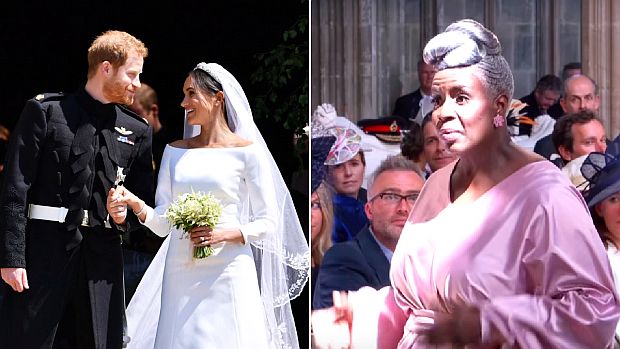
Prince Harry and Meghan Markle chose “Stand By Me” to be played at their May 19, 2018 wedding at the Windsor Castle. Before the couple exchanged their vows, Karen Gibson and The Kingdom Choir performed what was reported as “a stirring gospel rendition of the song.” The Choir later that year released their debut album, titled, “Stand By Me”. Click for album.
“Stand By Me” has also had a long cover history, recorded more than 500 times, and by a remarkable range of artists, among them: The Righteous Brothers. John Lennon, Tracy Chapman, Warren Zevon, Florence & The Machine, Mickey Gilley (a 1980 No, 1 Country hit & in film Urban Cowboy), Otis Redding, Prince Royce, and even Muhammad Ali (as Cassius Clay in 1963-64).
During his career, Ben E. King charted 21 songs on the Billboard Hot 100 between 1961 and 1975, including Top 10s, “Spanish Harlem,” “Stand by Me” and “Supernatural Thing, Part 1”. King continued touring in the U.S. and U.K as late as 2013-2014. He was also active in his charitable foundation, the Stand By Me Foundation, which helped provide educational support to deserving youth.Ben E. King died in April 2016, having suffered previously from coronary problems. He was 76. At the time of his death he was survived by his wife of 51 years, three children and six grandchildren.
For additional music stories, artist histories, and song profiles at this website see the “Annals of Music” category page. Thanks for visiting — and if you like what you find here, please make a donation to help support the research, writing, and continued publication of this website. Thank you. – Jack Doyle
|
Please Support Thank You |
____________________________________
Date Posted: 22 July 2021
Last Update: 4 July 2022
Comments to: jdoyle@pophistorydig.com
Twitter: https://twitter.com/PopHistoryDig
Article Citation:
Jack Doyle, “Stand By Me: Ben E. King Music,”
PopHistoryDig.com, July 22, 2021.
____________________________________
Sources, Links & Additional Information
“Ben E. King,” in Holly George-Warren and Patricia Romanowski (eds), The Rolling Stone Encyclopedia of Rock & Roll, Rolling Stone Press, New York, 3rd Edition, 2001, p. 526.
“Ben E. King,” Wikipedia.org.
“The Drifters,” Wikipedia.org.
“Stand By Me by Ben E. King,” SongFacts .com.
“Stand by Me (Ben E. King song),” Wikipe-dia.org.
“There Goes My Baby (The Drifters song),” Wikipedia.org.
Dave Marsh, The Heart of Rock and Soul, The 1001 Greatest Singles Ever Made, 1989, Da Capo Press, Paperback, 760 pp. Click for copy.
Ken Emerson, Always Magic in the Air: The Bomp and Brilliance of the Brill Building Era, 2005, Viking Press, 320pp. Click for copy.
“This Magic Moment – Ben E King and The Drifters,” YouTube.com, Posted, February 23, 2017.
“Ben E. King – Stand By Me,” YouTube.com, Posted, October 27, 2009.
William Grimes, “Ben E. King, Soulful Singer of ‘Stand by Me,’ Dies at 76,” New York Times, May 1, 2015.
Chris Payne, “’Stand By Me’ Singer Ben E. King Dead at 76,” Billboard, May 1, 2015.
Jason Gross. “’80s Levi’s Jeans Ads That Revived ’60s Music,” RediscoverThe80s.com, April 22, 2013.
“Levi’s 1988 Entrance,” YouTube.com, Posted, August 20, 2013.
Open Your Ears, “Stan Applebaum, the Master of Arranging, Tells His Secrets,” Local802 afm.org, Allegro, Volume 114, No. 12, December 2014.
Tim Jonze, “Ben E King’s ‘Stand By Me’: A Song as Enduring as the Love That Inspired It,” TheGuardian.com, May 1, 2015.
Stephen Thomas Erlewine, Nick Murray, and Brittany Spanos, “20 Best Covers of Ben E. King’s ‘Stand by Me.’ Hear Classic, Astounding and Unusual Interpretations by Artists Like John Lennon, Tina Turner and Miley Cyrus,” RollingStone.com, May 2, 2015.
“Three Things The Top 10 Royalty Earning Songs of All Time Have In Common,” Royalty News, February 20, 2017.
Paul Zollo, “Behind the Song: ‘Stand By Me’ by Ben. E. King, Leiber & Stoller,” American SongWriter.com, March 16, 2020.
Alex Lubet and Steven Lubet, “The Backstory of the Perfect Royal Wedding Song,” CNN .com, May 22, 2018.
______________________________
